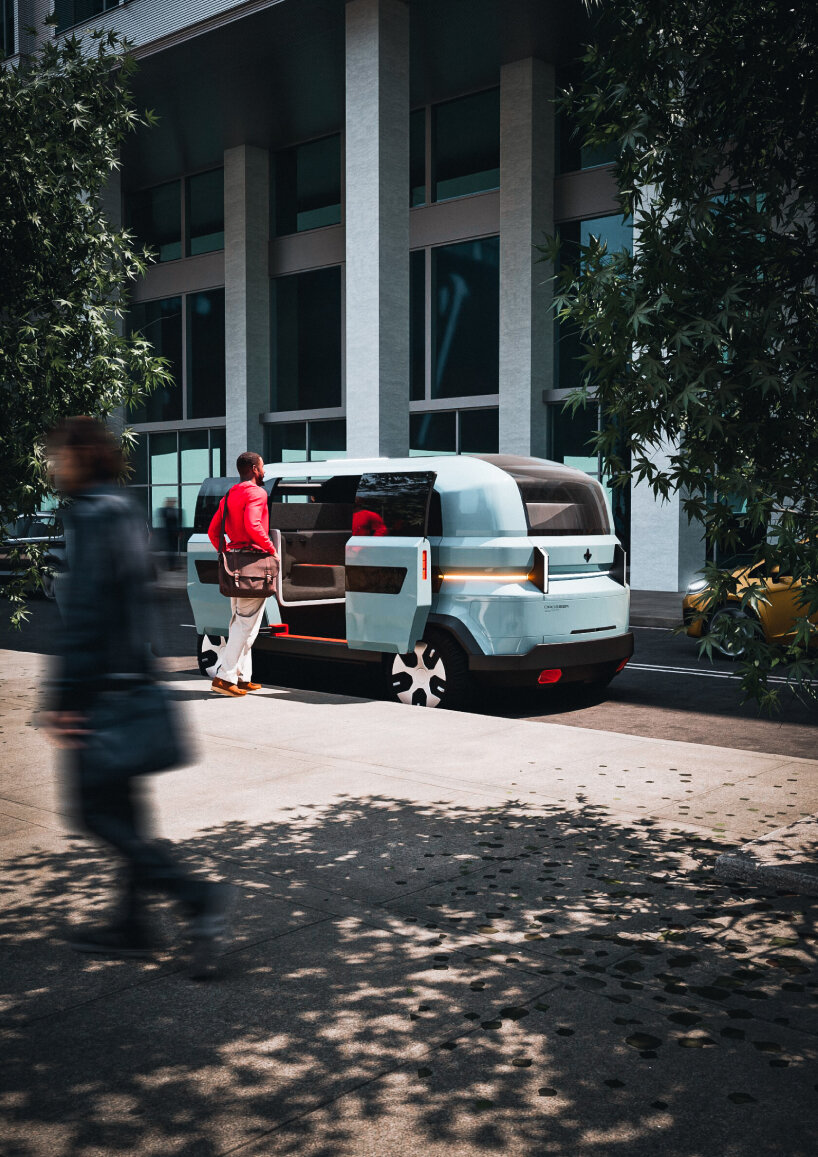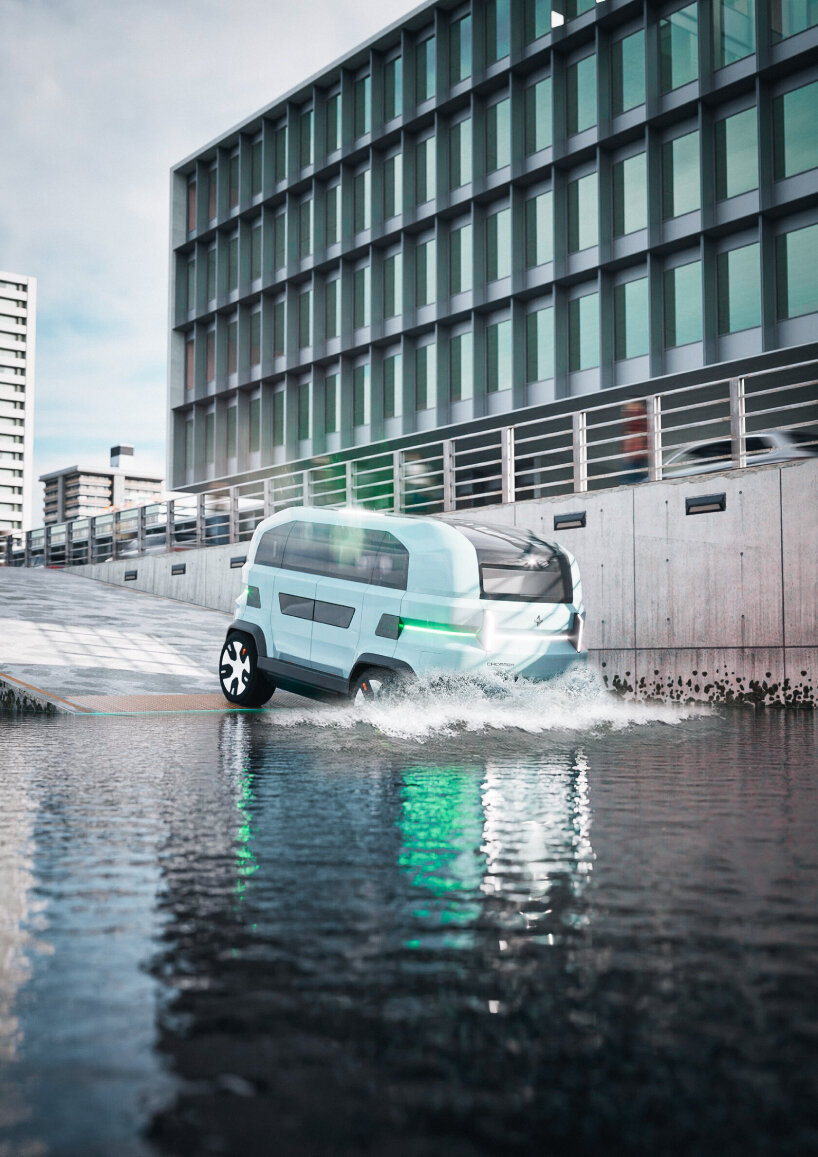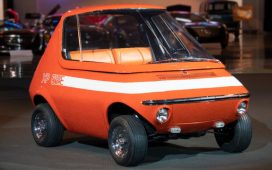Meet CROSSER, the autonomous amphibious vehicle
Designer Bernardo Pereira creates CROSSER, a concept autonomous amphibious vehicle that can drive in water when there’s a traffic jam on the road. First introduced in February 2024, the designer revises CROSSER, refining the flaws of the first version for the second model. The doors are now above the waterline, and the designer increases the width of the autonomous amphibious vehicle for more space. He also reduces the height of the seat to the ground as well as develops an app for the taxi service of the electric van-like vehicle.
Bernardo Pereira imagines CROSSER as modular too. It can either become a two-seater, pick-up truck with a cargo space at the rear, or a transport vehicle for field operations such as emergency response. If the vehicle is to be used as an emergency transport, there’s a mixed cockpit instead of a fully hands-free setting. In this way, the driver can still have a manual steering wheel with assistive autonomous driving. So far, the autonomous amphibious vehicle is still a concept project that drivers can take either in waterways or on the road.

all images courtesy of Bernardo Pereira
Modular interior that can accommodate four passengers
The interior of the autonomous amphibious vehicle CROSSER is modular. The setups are interchangeable with symmetrical two planes. The cabin has a smooth, rounded rectangular shape. It can accommodate more space and allow for additional interior equipment like speakers, if needed. There are four seats in total, two on each side, and there’s an ample amount of legroom in the middle. This area also doubles as temporary storage for when passengers have their stuff with them during the ride. Outside, the vehicle’s doors have NFC technology.
This means that only the booked passengers can open their doors. They place their smartphone near the LED screen on the doors. The automobile’s doors automatically close as well. When the sensors under the seats detect the weight of the passengers, they slide and shut. The screen outside CROSSER extends around the vehicle. It also conceals the cameras and sensors for the autonomous driving. Because of the sensors and cameras, they can detect the changes in the driving modes. With this, they adjust the vehicle’s setting on its own.

CROSSER is sleek enough to navigate traffic
ultrasonic sensors and thermal cameras around the automobile
When entering and exiting waterways like canals, the autonomous amphibious vehicle CROSSER slows down first before picking up speed. The front wheels rotate 30 degrees to adjust between land and water driving. When going back on the road, CROSSER’s suspension adjusts automatically to match road conditions. Designer Bernardo Pereira says that the vehicle aims to achieve Level 5 autonomy in driving in aquatic and terrestrial environments due to the technologies installed around the transport. These include RADAR, LIDAR, ultrasonic sensors, and thermal cameras that can capture the digital image of the automobile’s surroundings.
For the safety features of the concept autonomous amphibious vehicle, CROSSER uses real-time monitoring. Its sensors also detect collisions or impacts and automatically deploy airbags inside and outside the transport to protect the automobile and the passengers at once. The vehicle also doesn’t start unless all passengers fasten their seatbelts. Each passenger has access to a ‘stop’ button above their seat in case of an emergency. There’s also an external emergency flotation device on the side of the vehicle. When the autonomous amphibious vehicle faces problems while in waterways, the vehicle ejects the floating system on its own while passengers await emergency response.

passengers open the doors using their smartphones
For the structural design and layout of the concept autonomous amphibious vehicle, CROSSER has five sections with hydrojet outlets for propulsion in waterways. There’s an onboard computer placed near the wheel axles. The batteries for the electric ride are in the center to balance the weight. Speaking of weight distribution, the main structure of the vehicle comes with aluminum and magnesium alloy elements for a reduced overall load. There’s a hull at the bottom of CROSSER to help it float while in water and prevent it from sinking.
The hull uses polyurethane foam in it to add buoyancy, and there are four outlets – two at each end – to expel water for propulsion. The hull also has four openings for water intake and propellers inside each jet to increase the water flow. The bottom ridge of the hull has been lowered, with its slope increased compared to the previous version to make the vehicle more stable and easier to steer in water. The concept autonomous amphibious vehicle has four electric motors placed inside the wheels and behind the brake discs. Then, the charging port of CROSSER is in one of the corners of the automobile, protected from submerging in water.

the autonomous amphibious vehicle CROSSER can drive in waterways

it has hydrojets for water propulsion

the doors and seats are above the waterline











